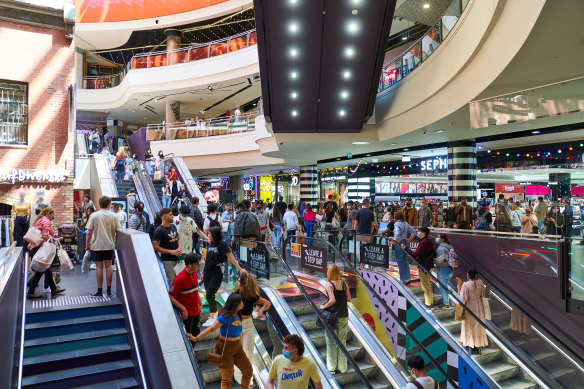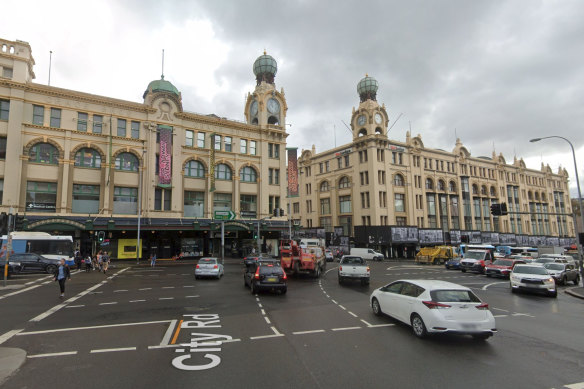Big Gun malls roar back to life, generating huge sales
Melbourne Central mall has roared back to life as shoppers flock to its Monopoly Dreams store, students meet to hang out and commuters come for lunch.
The GPT-owned shopping centre in the heart of Melbourne’s CBD was one of the hardest hit during the global pandemic given its location above the train station which was shut down during the state’s long lockdown.
Now its visitor numbers are at record levels and the centre has topped the polls for the first time since 2019, measured by its sales performance under the industry’s Moving Annual Turnover (MAT) metric, of $17,096 per square metre. It beat Mirvac’s Sydney Broadway Centre which generated $16,449 sales per square metre.

GPT-owned Melbourne Central shopping centre.
Despite cost of living pressures, retail landlords’ efforts to make shopping centres a destination and community hub appears to be paying off. Interactive stores like Monopoly Dreams and LEGO, cinemas and extended food courts are attracting more people who are happy to linger, longer.
Chris Barnett, head of retail and mixed use at GPT said the group was “thrilled” Melbourne Central had regained its number one position, particularly given the impact the pandemic had on the city’s retail sector.
“The recovery has been exceptional, and while office workers are yet to fully return to the CBD, it is clear that Victorian shoppers have embraced the importance of a vibrant city centre,” Barnett said.
The 2024 Big Guns report, released on Thursday by the industry’s Shopping Centre News (SCN) at an event attended by a who’s who in retail, 12 centres now record MAT exceeding $1 billion. Eight of these are Westfield Centres. QIC joins the club for the first time with its Robina Town Centre on the Gold Coast performing strongly.
Big Gun centres cover 50,000 square metres or more and feature department stores, supermarkets, discount department stores and the full range of specialty shops. In all, 93 shopping centres were listed in the report and according to Michael Lloyd, SCN’s Publisher, more than 90 per cent of them showed healthy increases in turnover over the previous year.
“Australian shopping centres are community focal points,” Lloyd said.
“They are part of our community infrastructure just as are schools, hospitals and social clubs; they are places for social interaction and are managed as such. As community needs and wants change, so do our centres; they are responsive to the market.”
Vicinity and Gandel’s jointly owned Chadstone, in Melbourne’s south-east, still holds the number one spot in sales, with $2.67 billion, unchanged from the previous year, while Scentre Group’s Westfield Chermside in Brisbane recorded a 6.3 per cent increase, placing it second with MAT of $1.3 billion.
Lloyd said the latest Big Guns results clearly showed the resilience of Australian shopping centres. He said Australia led the world in shopping centre development and management and had done so for many years.
Since their inception in the 1960s they’ve been the most sought-after assets by global funds because of their unwavering growth in terms of return on investment.
“If you want an indication of how solid that is, look at Westfield as an example,” Lloyd said.
Lloyd predicts that by 2028, a centre will need to have an annual turnover of $1 billion to make it into the top 20.
Looking at the numbers for specialty stores, which are usually about 400 square metres in size, the most profitable was Chadstone, recording $26,859 per square metre, up 27 per cent on the previous year.
‘Our centres have gone far beyond the mall status.’
SCN Publisher Michael Lloyd
“Our centres have gone far beyond the mall status,” Lloyd said at the SCN event.

Sydney’s Broadway Shopping Centre.
“No longer are they simply retail, leisure and entertainment centres, but, as community focal points, they have become integral parts of the community in the same way as hospitals, train stations and even schools.”
Barnett said Melbourne Central has evolved from a CBD workers’ place of convenience to a weekend destination.
“The asset has become a must-do tourism attraction in Melbourne off the back of unique offerings like Monopoly Dreams, which is bringing the highest selling board game of all time to life,” he said.
Ben Gilbert, retail analyst at Jarden, said in a note to clients that “the worst is behind us” for the sector.
“That was our key takeaway from consumer results with earnings per share about 7 per cent ahead of expectations and management talking to spending resilience, rational promotions and cost control,” Gilbert said.
But he said consumers are prepared to shop around for bargains.
The emergence of value focused shoppers is creating challenges in three broad ways: share on promotion and the focus on discounts is up; more cross-shopping with leakage from supermarkets to the likes of Chemist Warehouse; and loyalty programs appear less effective, he said.
The Business Briefing newsletter delivers major stories, exclusive coverage and expert opinion. Sign up to get it every weekday morning.